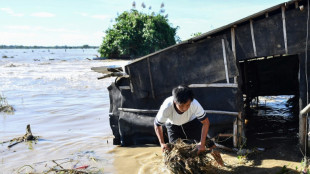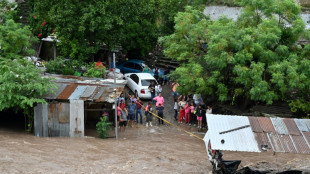
-
 Sex, drugs and gritty reality on Prague's underworld tours
Sex, drugs and gritty reality on Prague's underworld tours
-
Farmers descend on London to overturn inheritance tax change

-
 Clippers upset Warriors, Lillard saves Bucks
Clippers upset Warriors, Lillard saves Bucks
-
Acquitted 'Hong Kong 47' defendant sees freedom as responsibility

-
 Floods strike thousands of houses in northern Philippines
Floods strike thousands of houses in northern Philippines
-
Illegal farm fires fuel Indian capital's smog misery

-
 SpaceX set for Starship's next flight, Trump expected to attend
SpaceX set for Starship's next flight, Trump expected to attend
-
Texans cruise as Cowboys crisis deepens

-
 Do the Donald! Trump dance takes US sport by storm
Do the Donald! Trump dance takes US sport by storm
-
Home hero Cameron Smith desperate for first win of 2024 at Australian PGA

-
 Team Trump assails Biden decision on missiles for Ukraine
Team Trump assails Biden decision on missiles for Ukraine
-
Hong Kong court jails 45 democracy campaigners on subversion charges

-
 Several children injured in car crash at central China school
Several children injured in car crash at central China school
-
Urban mosquito sparks malaria surge in East Africa

-
 Djibouti experiments with GM mosquito against malaria
Djibouti experiments with GM mosquito against malaria
-
Pulisic at the double as USA cruise past Jamaica

-
 Many children injured after car crashes at central China school: state media
Many children injured after car crashes at central China school: state media
-
Asian markets rally after US bounce as Nvidia comes into focus

-
 Tens of thousands march in New Zealand Maori rights protest
Tens of thousands march in New Zealand Maori rights protest
-
Five takeaways from the G20 summit in Rio

-
 China, Russia ministers discuss Korea tensions at G20: state media
China, Russia ministers discuss Korea tensions at G20: state media
-
Kohli form, opening woes dog India ahead of Australia Test series

-
 Parts of Great Barrier Reef suffer highest coral mortality on record
Parts of Great Barrier Reef suffer highest coral mortality on record
-
Defiant Lebanese harvest olives in the shadow of war

-
 Russian delegations visit Pyongyang as Ukraine war deepens ties
Russian delegations visit Pyongyang as Ukraine war deepens ties
-
S.Africa offers a lesson on how not to shut down a coal plant

-
 Italy beat Swiatek's Poland to reach BJK Cup final
Italy beat Swiatek's Poland to reach BJK Cup final
-
Japan, UK to hold regular economic security talks

-
 Divided G20 fails to agree on climate, Ukraine
Divided G20 fails to agree on climate, Ukraine
-
Can the Trump-Musk 'bromance' last?

-
 US to call for Google to sell Chrome browser: report
US to call for Google to sell Chrome browser: report
-
Macron hails 'good' US decision on Ukraine missiles

-
 Italy eliminate Swiatek's Poland to reach BJK Cup final
Italy eliminate Swiatek's Poland to reach BJK Cup final
-
Trump expected to attend next Starship rocket launch: reports

-
 Israeli strike on Beirut kills 5 as deadly rocket fire hits Israel
Israeli strike on Beirut kills 5 as deadly rocket fire hits Israel
-
Gvardiol steals in to ensure Croatia reach Nations League quarter-finals

-
 Thousands march to New Zealand's parliament in Maori rights protest
Thousands march to New Zealand's parliament in Maori rights protest
-
China's Xi urges G20 to help 'cool' Ukraine crisis

-
 Church and state clash over entry fee for Paris's Notre Dame
Church and state clash over entry fee for Paris's Notre Dame
-
Holders Spain strike late to beat Switzerland in Nations League

-
 Stocks, dollar hesitant as traders brace for Nvidia earnings
Stocks, dollar hesitant as traders brace for Nvidia earnings
-
Swiatek saves Poland against Italy in BJK Cup semi, forces doubles decider

-
 Biden in 'historic' pledge for poor nations ahead of Trump return
Biden in 'historic' pledge for poor nations ahead of Trump return
-
Sudan, Benin qualify, heartbreak for Rwanda after shocking Nigeria

-
 Five dead in new Israeli strike on Beirut's centre
Five dead in new Israeli strike on Beirut's centre
-
Where's Joe? G20 leaders have group photo without Biden

-
 US permission to fire missiles on Russia no game-changer: experts
US permission to fire missiles on Russia no game-changer: experts
-
Tropical storm Sara kills four in Honduras and Nicaragua

-
 Germany, Finland warn of 'hybrid warfare' after sea cable cut
Germany, Finland warn of 'hybrid warfare' after sea cable cut
-
Spanish resort to ban new holiday flats in 43 neighbourhoods


Illegal gold mining eats into Peruvian Amazon
On the banks of the Madre de Dios river, dredges work day and night in search of gold, part of a scourge of illegal mining that is slowly devouring the Peruvian Amazon.
This mega-diverse region of southeast Peru has lost on average 21,000 hectares (52,000 acres) of rain forest -- an area twice the size of Paris -- every year since 2017 despite policing efforts locals say are insufficient.
Where trees used to stand there are now deep sinkholes flooded with brown water where dredges sift through mountains of rubble for the valuable particles.
"The community can no longer plant their corn, their bananas, their cassava, because this land is practically dead," Jaime Vargas, a 47-year-old Shipibo Indigenous leader and reforestation activist, told AFP.
Although mining is prohibited in their territories, Indigenous people have no choice but to coexist with invading gold prospectors in the Madre de Dios department of some 180,000 inhabitants near Peru's borders with Brazil and Bolivia.
Some even end up working for them.
As the international price of gold soared in recent years to reach an all-time high in May, the hunt for the precious metal has only increased in Peru -- the world's tenth biggest producer and second in Latin America, according to the US Geological Survey.
- 'No production record' -
Illegal gold mining, which happens alongside legal, government-regulated extraction, is a major source of financing for organized crime in places like La Pampa, a lawless enclave in Madre de Dios.
"Illegal miners are invading us from all sides," resident Lucio Quispe, 40, told AFP with more resignation than anger.
With his two brothers, Quispe runs a 200-hectare concession granted by the state.
Just hours before the interview, his brothers were brutally attacked by machete-wielding men in a region where clashes over mining spots often turn violent.
A process has been underway since 2016 to issue licences to informal but sanctioned miners such as the Quispes.
In 2022, official data showed Peru produced 96 tons of gold -- but exported about 180 tons to Canada, India, Switzerland and the United States.
"Forty-five percent of exports have no production record," according to an official body tasked with overseeing Peruvian banks and combating money laundering.
Independent studies have named Peru as the largest exporter of illegal gold in South America, with 44 percent of the total, ahead of Colombia with 25 percent and Bolivia with 12 percent, according to the Peruvian Institute of Economics, a think tank.
- 'Sacrificing the forest' -
Trying to get a grip on the problem and protect nature reserves in Madre de Dios, Peru in 2010 demarcated a corridor of 5,000 square kilometers (1,930 square miles) where informal miners will be allowed to operate until the end of this year.
Of the 9,000 informal miners registered by the 2019 cutoff date, only about 200 have obtained a licence to date, according to Augusto Villegas, regional director of energy and mines for Madre de Dios.
In the corridor, every 100 cubic meters of soil dredged yields about 10 to 15 grams (0.35 to 0.53 ounces) of alluvial gold, which today fetches a price of about $63 per gram.
"You can't make an omelette without breaking eggs; you can't mine in Madre de Dios without sacrificing the forest," said Villegas.
Many miners also continue to use toxic mercury to separate gold from the sediment, despite Peru signing an international agreement to scale down its use, and banning imports in 2015.
As the price of mercury exploded, some small-scale miners decided to take a bet on "ecological gold."
Lucila Huanco, 54, said she stopped using mercury three years ago on her 3,000-hectare concession, instead using a gravitational technique to release the gold.
At first, her gold fetched a lower price for its appearance, different to gold mined using mercury. But then she reached an agreement with a buyer in Lima who pays her about $70 per gram.
"Honestly," Huanco said, "I don't want us to be known as polluters anymore."
R.Lee--AT


